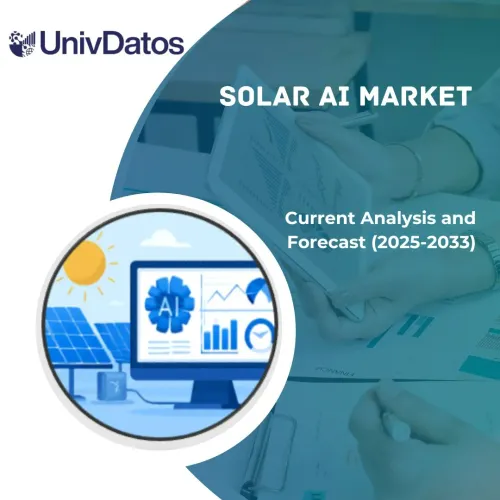- Startseite
- Über uns
- Industrie
- Dienstleistungen
- Lesen
- Kontaktieren Sie uns
Markt für saubere Kohletechnologie: Aktuelle Analyse und Prognose (2024-2032)
Schwerpunkt auf Technologie {Verbrennungstechnologie (Wirbelschichtfeuerung, Flugstromfeuerung), Vergasungstechnologie (Integrierte Kohlevergasung, Wasserstoff aus Kohle-Verfahren, Mehrzweck-Kohlevergasung), Ermöglichungstechnologie, Technologie zur Kohlenstoffabscheidung und -speicherung, Technologie zur Kohlenstoffsequestrierung}; und Region/Land
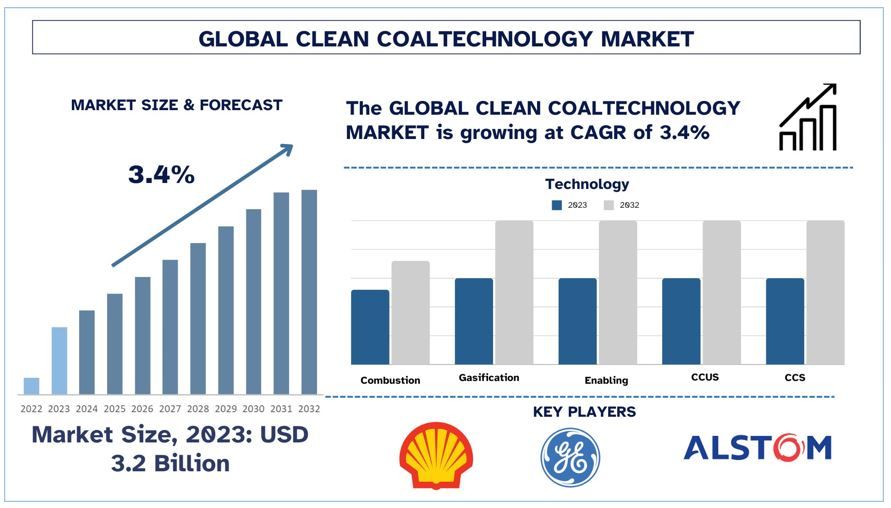 Marktgröße und -prognose für saubere Kohletechnologie
Marktgröße und -prognose für saubere Kohletechnologie
Der Markt für saubere Kohletechnologie wurde im Jahr 2023 auf 3,2 Milliarden USD geschätzt und wird voraussichtlich mit einer soliden CAGR von rund 3,4 % im Prognosezeitraum (2024-2032) wachsen. Saubere Kohletechnologie (CCT) ist ein Begriff, der verschiedene Technologien und Innovationen umfasst, die darauf abzielen, Emissionen wie Flugasche, Partikel und Gase wie Kohlendioxid (CO2), Kohlenstoffmonoxid (CO) und Stickoxide (NOX) aus der Kohleindustrie zu reduzieren. Ziel ist es, Umweltbedenken zu minimieren. Es bestehen jedoch immer noch Bedenken hinsichtlich der wirtschaftlichen Tragfähigkeit, der Gesamtumsetzbarkeit und des Zeitrahmens für die Bereitstellung dieser Technologien.
Marktanalyse für saubere Kohletechnologie
Saubere Kohletechnologien (CCTs) zielen darauf ab, Kohle zur Stromerzeugung auf umweltfreundlichere und wirtschaftlichere Weise zu nutzen. Sie umfassen Verfahren, die vor, während und nach der Nutzung angewendet werden können. Es gibt zwei Hauptansätze zur Entwicklung sauberer Kohletechnologien. Der erste Ansatz besteht darin, thermisch effizientere Systeme zu entwickeln, die weniger Kohle zur Erzeugung der gleichen Strommenge verbrauchen, was zu reduzierten Emissionen führt. Dieser Ansatz hat den Vorteil, dass der Umfang der erforderlichen Rauchgasreinigung reduziert wird. Der andere Ansatz besteht darin, neue Methoden zur effektiven und kostengünstigen Reinigung der Emissionen zu verbessern und zu entwickeln.
Markttrends für saubere Kohletechnologie
Fortschritt und weit verbreitete Einführung der Technologie zur Kohlenstoffabscheidung, -nutzung und -speicherung (CCUS)
CCUS befasst sich mit einem der wichtigsten Umweltprobleme, die mit Kohlekraftwerken verbunden sind, von denen die bemerkenswerteste die Freisetzung von Kohlendioxid (CO2) ist, einem bekannten Treibhausgas. Es beinhaltet das Einfangen der CO2-Emissionen an der Quelle, wie z. B. in Stromerzeugern oder Fabriken, und dann entweder die dauerhafte Sequestrierung oder das Recycling oder die Verwendung in anderen notwendigen Prozessen. Die CCUS-Technologie ist entscheidend, um erhebliche Kürzungen der Kohlendioxidemissionen aus der Kohleverstromung zu erreichen, gemäß globalen Klimazielen wie denen des Pariser Abkommens. Die Effizienz der Speicherung oder Nutzung von CO2 reduziert das Ausmaß des Umweltschadens durch Kohle und macht sie somit umweltfreundlicher. Dies ist besonders wichtig für Länder mit hohem Kohleverbrauch und solche, die ohne Kompromisse bei der Energieverfügbarkeit in sauberere Energiequellen diversifizieren wollen.
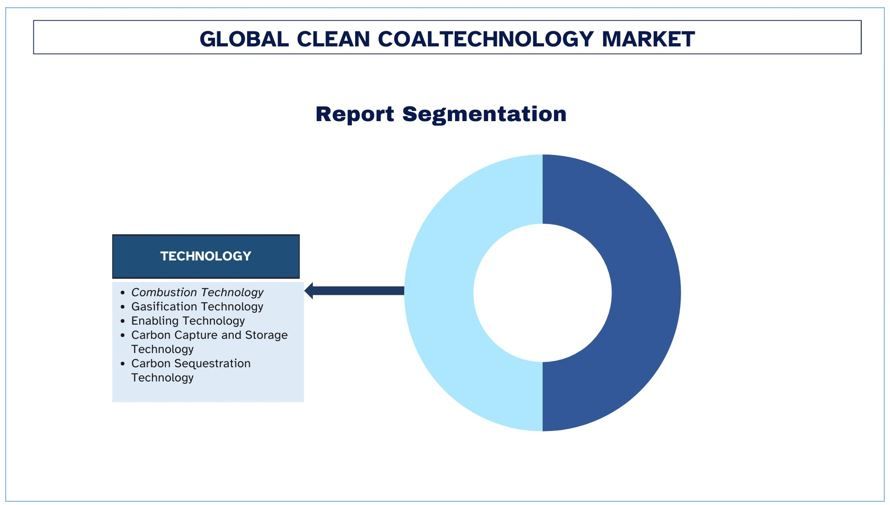
Nordamerika wird voraussichtlich mit einer signifikanten CAGR im Prognosezeitraum wachsen
Nordamerika, insbesondere die Vereinigten Staaten und Kanada, hat sich zu einem bedeutenden Akteur auf dem Markt für saubere Kohletechnologie entwickelt. Diese Führungsrolle ist auf mehrere Faktoren zurückzuführen, darunter robuste Regierungspolitik, erhebliche Investitionen in Forschung und Entwicklung sowie die Umsetzung groß angelegter Projekte, die die Machbarkeit und den Nutzen sauberer Kohletechnologien demonstrieren. Die US-Regierung hat saubere Kohletechnologien historisch durch verschiedene Richtlinien und regulatorische Rahmenbedingungen unterstützt. Initiativen wie das Clean Coal Technology Program (CCTP) und der Energy Policy Act haben Finanzmittel und Anreize für die Entwicklung und den Einsatz sauberer Kohletechnologien bereitgestellt. Das US-Energieministerium (DOE) spielt eine entscheidende Rolle, indem es Forschungsprojekte finanziert, die darauf abzielen, die Effizienz zu verbessern und die Umweltauswirkungen von Kohlekraftwerken zu reduzieren.
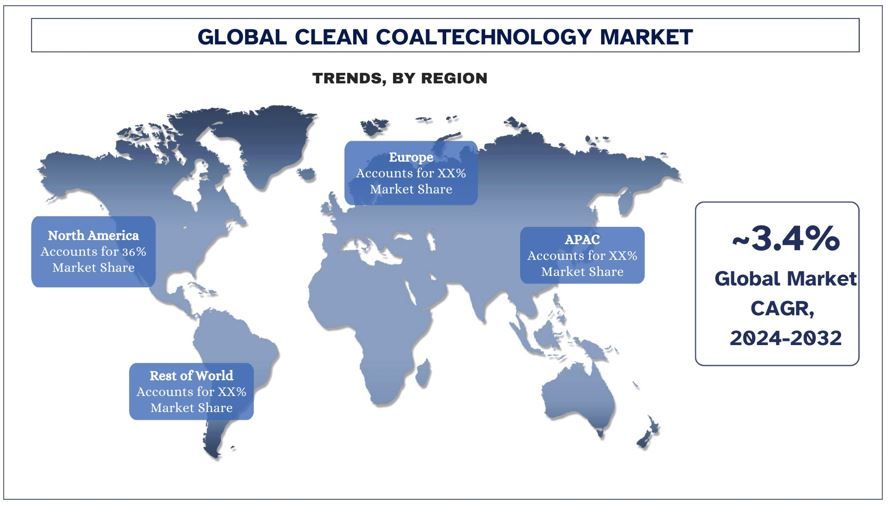
Branchenüberblick über saubere Kohletechnologie
Der Markt für saubere Kohletechnologie ist wettbewerbsintensiv und fragmentiert, mit einer Präsenz mehrerer globaler und internationaler Marktteilnehmer. Die wichtigsten Akteure verfolgen unterschiedliche Wachstumsstrategien, um ihre Marktpräsenz zu erhöhen, wie z. B. Partnerschaften, Vereinbarungen, Kooperationen, Produkteinführungen, geografische Expansionen sowie Fusionen und Übernahmen. Einige der wichtigsten Akteure auf dem Markt sind Royal Dutch Shell PLC, General Electric Company, Alstom Power Siemens AG, Clean Coal Technologies Inc., KBR Inc, Siemens AG, Mitsubishi Electric, Toshiba, BHEL und Harbin Electric Company.
Markt-News für saubere Kohletechnologie
Im Jahr 2023 kündigten GE Gas Power, ein Teil von GE Vernova, und Svante eine gemeinsame Entwicklungsvereinbarung (JDA) zur Entwicklung und Bewertung der Feststoffsorptionsmittel-basierten Kohlenstoffabscheidungstechnologie für Erdgasstromerzeugungsanwendungen an.
Im Jahr 2023 unterzeichnete KBR ein Memorandum of Understanding (MoU) mit SolydEra, um eine integrierte Lösung zur Herstellung von kostengünstigerem sauberem Ammoniak unter Verwendung erneuerbarer Energien anzubieten.
Marktberichtsabdeckung für saubere Kohletechnologie
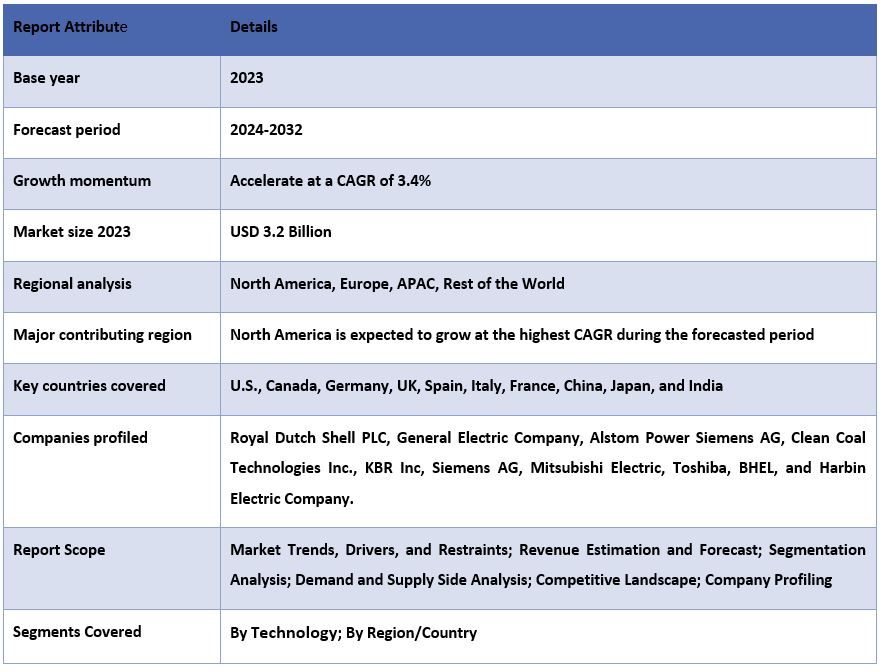
Gründe für den Kauf dieses Berichts:
- Die Studie beinhaltet eine Marktabschätzungs- und Prognoseanalyse, die von authentifizierten wichtigen Branchenexperten validiert wurde.
- Der Bericht bietet einen schnellen Überblick über die Gesamtleistung der Branche auf einen Blick.
- Der Bericht umfasst eine eingehende Analyse prominenter Branchenkollegen mit einem primären Fokus auf wichtige Geschäftsfinanzen, Produktportfolios, Expansionsstrategien und aktuelle Entwicklungen.
- Detaillierte Untersuchung von Treibern, Beschränkungen, wichtigen Trends und Chancen, die in der Branche vorherrschen.
- Die Studie deckt den Markt umfassend über verschiedene Segmente ab.
- Detaillierte Analyse der Branche auf regionaler Ebene.
Anpassungsoptionen:
Der globale Markt für saubere Kohletechnologie kann je nach Anforderung oder einem anderen Marktsegment weiter angepasst werden. Darüber hinaus versteht UMI, dass Sie möglicherweise Ihre eigenen Geschäftsanforderungen haben, daher können Sie sich gerne mit uns in Verbindung setzen, um einen Bericht zu erhalten, der Ihren Anforderungen vollständig entspricht.
Inhaltsverzeichnis
Forschungsmethodik für die Marktanalyse für saubere Kohletechnologie (2024-2032)
Die Analyse des historischen Marktes, die Schätzung des aktuellen Marktes und die Prognose des zukünftigen Marktes des globalen Marktes für saubere Kohletechnologie waren die drei Hauptschritte, die unternommen wurden, um die Einführung der sauberen Kohletechnologie in wichtigen Regionen weltweit zu erstellen und zu analysieren. Es wurden umfangreiche Sekundärrecherchen durchgeführt, um die historischen Marktzahlen zu sammeln und die aktuelle Marktgröße zu schätzen. Zweitens wurden zahlreiche Erkenntnisse und Annahmen berücksichtigt, um diese Erkenntnisse zu validieren. Darüber hinaus wurden ausführliche Primärinterviews mit Branchenexperten entlang der Wertschöpfungskette des globalen Marktes für saubere Kohletechnologie durchgeführt. Nach Annahme und Validierung der Marktzahlen durch Primärinterviews wandten wir einen Top-down/Bottom-up-Ansatz an, um die gesamte Marktgröße zu prognostizieren. Danach wurden Methoden zur Marktaufschlüsselung und Datentriangulation angewendet, um die Marktgröße von Segmenten und Untersegmenten der Branche zu schätzen und zu analysieren. Die detaillierte Methodik wird im Folgenden erläutert:
Analyse der historischen Marktgröße
Schritt 1: Eingehende Untersuchung von Sekundärquellen:
Es wurde eine detaillierte Sekundärstudie durchgeführt, um die historische Marktgröße des Marktes für saubere Kohletechnologie über interne Unternehmensquellen wie Jahresberichte und Finanzberichte, Präsentationen zur Leistungsfähigkeit, Pressemitteilungen usw. und externe Quellen einschließlich Zeitschriften, Nachrichten und Artikel, Regierungsveröffentlichungen, Wettbewerberpublikationen, Sektorberichte, Datenbanken von Drittanbietern und andere glaubwürdige Veröffentlichungen zu erhalten.
Schritt 2: Marktsegmentierung:
Nachdem wir die historische Marktgröße des Marktes für saubere Kohletechnologie erhalten hatten, führten wir eine detaillierte Sekundäranalyse durch, um historische Markteinblicke und -anteile für verschiedene Segmente und Untersegmente für wichtige Regionen zu sammeln. Zu den wichtigsten Segmenten, die im Bericht enthalten sind, gehören Technologie und Region. Darüber hinaus wurden Analysen auf Länderebene durchgeführt, um die Gesamtannahme von Testmodellen in dieser Region zu bewerten.
Schritt 3: Faktorenanalyse:
Nachdem wir die historische Marktgröße verschiedener Segmente und Untersegmente erfasst hatten, führten wir eine detaillierte Faktorenanalyse durch, um die aktuelle Marktgröße des Marktes für saubere Kohletechnologie zu schätzen. Darüber hinaus führten wir eine Faktorenanalyse mit abhängigen und unabhängigen Variablen wie der Technologie des Marktes für saubere Kohletechnologie durch. Es wurde eine gründliche Analyse der Angebots- und Nachfrageszenarien unter Berücksichtigung der wichtigsten Partnerschaften, Fusionen und Übernahmen, Geschäftserweiterungen und Produkteinführungen im Sektor für saubere Kohletechnologie weltweit durchgeführt.
Schätzung und Prognose der aktuellen Marktgröße
Aktuelle Marktgrößenbestimmung: Basierend auf umsetzbaren Erkenntnissen aus den obigen 3 Schritten kamen wir zur aktuellen Marktgröße, den wichtigsten Akteuren auf dem globalen Markt für saubere Kohletechnologie und den Marktanteilen der Segmente. Alle erforderlichen prozentualen Anteilsaufteilungen und Marktaufschlüsselungen wurden mit dem oben genannten sekundären Ansatz ermittelt und durch Primärinterviews verifiziert.
Schätzung und Prognose:Für die Marktschätzung und -prognose wurden verschiedenen Faktoren Gewichte zugewiesen, darunter Treiber und Trends, Beschränkungen und Chancen, die für die Stakeholder verfügbar sind. Nach der Analyse dieser Faktoren wurden relevante Prognosetechniken, d. h. der Top-down/Bottom-up-Ansatz, angewendet, um die Marktprognose für 2032 für verschiedene Segmente und Untersegmente in den wichtigsten Märkten weltweit zu erstellen. Die Forschungsmethodik zur Schätzung der Marktgröße umfasst:
- Die Marktgröße der Branche in Bezug auf den Umsatz (USD) und die Akzeptanzrate des Marktes für saubere Kohletechnologie in den wichtigsten Märkten im Inland
- Alle prozentualen Anteile, Aufteilungen und Aufschlüsselungen der Marktsegmente und -untersegmente
- Wichtige Akteure auf dem globalen Markt für saubere Kohletechnologie in Bezug auf die angebotenen Produkte. Außerdem die Wachstumsstrategien, die diese Akteure anwenden, um in dem schnell wachsenden Markt zu konkurrieren
Validierung von Marktgröße und -anteil
Primärforschung: Es wurden eingehende Interviews mit den wichtigsten Meinungsführern (KOLs) geführt, darunter Führungskräfte der obersten Ebene (CXO/VPs, Vertriebsleiter, Marketingleiter, Betriebsleiter, Regionalleiter, Länderleiter usw.) in den wichtigsten Regionen. Die Ergebnisse der Primärforschung wurden dann zusammengefasst, und es wurde eine statistische Analyse durchgeführt, um die aufgestellte Hypothese zu beweisen. Die Eingaben aus der Primärforschung wurden mit den Ergebnissen der Sekundärforschung konsolidiert, wodurch Informationen in umsetzbare Erkenntnisse umgewandelt wurden.
Aufteilung der primären Teilnehmer in verschiedenen Regionen
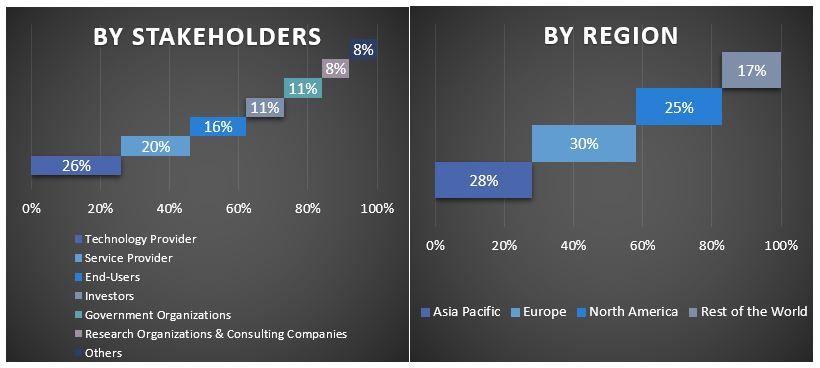
Markttechnik
Die Daten-Triangulationstechnik wurde eingesetzt, um die gesamte Marktschätzung abzuschließen und präzise statistische Zahlen für jedes Segment und Untersegment des globalen Marktes für Clean Coal Technology zu ermitteln. Die Daten wurden nach der Untersuchung verschiedener Parameter und Trends in den Bereichen der Technologie auf dem globalen Markt für Clean Coal Technology in mehrere Segmente und Untersegmente aufgeteilt.
Das Hauptziel der Global Clean Coal Technology Market Studie
Die aktuellen und zukünftigen Markttrends des globalen Marktes für Clean Coal Technology wurden in der Studie ermittelt. Investoren können strategische Erkenntnisse gewinnen, um ihre Investitionsentscheidungen auf der in der Studie durchgeführten qualitativen und quantitativen Analyse zu basieren. Aktuelle und zukünftige Markttrends bestimmten die Gesamtattraktivität des Marktes auf regionaler Ebene und boten den Industrieakteuren eine Plattform, um den unerschlossenen Markt zu erschließen und von einem First-Mover-Vorteil zu profitieren. Weitere quantitative Ziele der Studien umfassen:
- Analysieren Sie die aktuelle und prognostizierte Marktgröße des Clean Coal Technology-Marktes in Bezug auf den Wert (USD). Analysieren Sie auch die aktuelle und prognostizierte Marktgröße verschiedener Segmente und Untersegmente.
- Segmente in der Studie umfassen Bereiche der
- Definieren und analysieren Sie den regulatorischen Rahmen für Clean Coal Technology
- Analysieren Sie die Wertschöpfungskette, die mit der Präsenz verschiedener Intermediäre verbunden ist, sowie die Analyse des Kunden- und Wettbewerbsverhaltens der Branche.
- Analysieren Sie die aktuelle und prognostizierte Marktgröße des Clean Coal Technology-Marktes für die wichtigsten Regionen.
- Zu den wichtigsten Ländern der in dem Bericht untersuchten Regionen gehören Asien-Pazifik, Europa, Nordamerika und der Rest der Welt
- Unternehmensprofile des Clean Coal Technology-Marktes und die Wachstumsstrategien der Marktteilnehmer zur Aufrechterhaltung auf dem schnell wachsenden Markt.
- Detaillierte Analyse der Branche auf regionaler Ebene
Häufig gestellte Fragen FAQs
Q1: Wie groß ist die aktuelle Marktgröße und das Wachstumspotenzial des Clean Coal Technology-Marktes?
Q2: Was sind die treibenden Faktoren für das Wachstum des Marktes für Clean Coal Technology?
Q3: Welches Segment hat den größten Anteil am Markt für Clean Coal Technology nach Technologie?
Q4: Was sind die aufkommenden Technologien und Trends auf dem Markt für Clean Coal Technology?
Q5: Welche Region wird den Markt für Clean Coal Technology dominieren?
Verwandt Berichte
Kunden, die diesen Artikel gekauft haben, kauften auch








